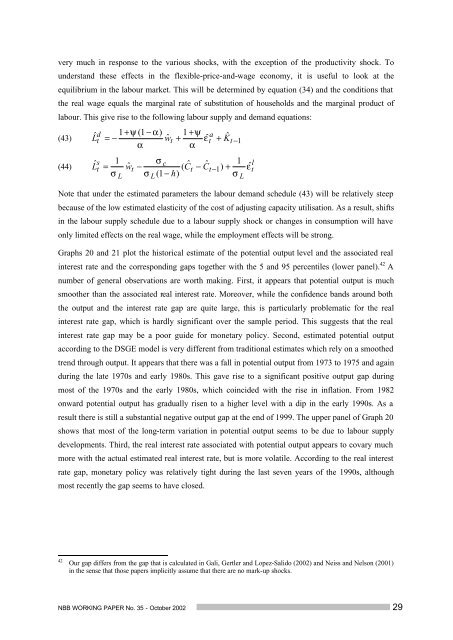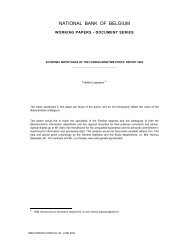An estimated dynamic stochastic general equilibrium model of the ...
An estimated dynamic stochastic general equilibrium model of the ...
An estimated dynamic stochastic general equilibrium model of the ...
Create successful ePaper yourself
Turn your PDF publications into a flip-book with our unique Google optimized e-Paper software.
very much in response to <strong>the</strong> various shocks, with <strong>the</strong> exception <strong>of</strong> <strong>the</strong> productivity shock. Tounderstand <strong>the</strong>se effects in <strong>the</strong> flexible-price-and-wage economy, it is useful to look at <strong>the</strong><strong>equilibrium</strong> in <strong>the</strong> labour market. This will be determined by equation (34) and <strong>the</strong> conditions that<strong>the</strong> real wage equals <strong>the</strong> marginal rate <strong>of</strong> substitution <strong>of</strong> households and <strong>the</strong> marginal product <strong>of</strong>labour. This give rise to <strong>the</strong> following labour supply and demand equations:(43) ˆd1+ψ (1 −α)1+ψ= −ˆ + ˆaL+ ˆtwtεtKt−1αα(44)Lˆ1σsct = wˆt − ( Ct− Ct−1 ) +σ L σ L(1− h)ˆˆNote that under <strong>the</strong> <strong>estimated</strong> parameters <strong>the</strong> labour demand schedule (43) will be relatively steepbecause <strong>of</strong> <strong>the</strong> low <strong>estimated</strong> elasticity <strong>of</strong> <strong>the</strong> cost <strong>of</strong> adjusting capacity utilisation. As a result, shiftsin <strong>the</strong> labour supply schedule due to a labour supply shock or changes in consumption will haveonly limited effects on <strong>the</strong> real wage, while <strong>the</strong> employment effects will be strong.Graphs 20 and 21 plot <strong>the</strong> historical estimate <strong>of</strong> <strong>the</strong> potential output level and <strong>the</strong> associated realinterest rate and <strong>the</strong> corresponding gaps toge<strong>the</strong>r with <strong>the</strong> 5 and 95 percentiles (lower panel). 42 <strong>An</strong>umber <strong>of</strong> <strong>general</strong> observations are worth making. First, it appears that potential output is muchsmoo<strong>the</strong>r than <strong>the</strong> associated real interest rate. Moreover, while <strong>the</strong> confidence bands around both<strong>the</strong> output and <strong>the</strong> interest rate gap are quite large, this is particularly problematic for <strong>the</strong> realinterest rate gap, which is hardly significant over <strong>the</strong> sample period. This suggests that <strong>the</strong> realinterest rate gap may be a poor guide for monetary policy. Second, <strong>estimated</strong> potential outputaccording to <strong>the</strong> DSGE <strong>model</strong> is very different from traditional estimates which rely on a smoo<strong>the</strong>dtrend through output. It appears that <strong>the</strong>re was a fall in potential output from 1973 to 1975 and againduring <strong>the</strong> late 1970s and early 1980s. This gave rise to a significant positive output gap duringmost <strong>of</strong> <strong>the</strong> 1970s and <strong>the</strong> early 1980s, which coincided with <strong>the</strong> rise in inflation. From 1982onward potential output has gradually risen to a higher level with a dip in <strong>the</strong> early 1990s. As aresult <strong>the</strong>re is still a substantial negative output gap at <strong>the</strong> end <strong>of</strong> 1999. The upper panel <strong>of</strong> Graph 20shows that most <strong>of</strong> <strong>the</strong> long-term variation in potential output seems to be due to labour supplydevelopments. Third, <strong>the</strong> real interest rate associated with potential output appears to covary muchmore with <strong>the</strong> actual <strong>estimated</strong> real interest rate, but is more volatile. According to <strong>the</strong> real interestrate gap, monetary policy was relatively tight during <strong>the</strong> last seven years <strong>of</strong> <strong>the</strong> 1990s, althoughmost recently <strong>the</strong> gap seems to have closed.1σLltεˆ42Our gap differs from <strong>the</strong> gap that is calculated in Gali, Gertler and Lopez-Salido (2002) and Neiss and Nelson (2001)in <strong>the</strong> sense that those papers implicitly assume that <strong>the</strong>re are no mark-up shocks.NBB WORKING PAPER No. 35 - October 2002 29
















